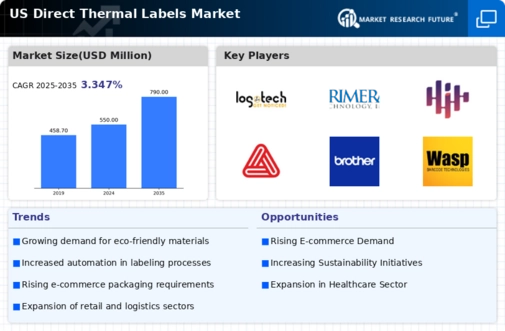Rising Demand in Retail Sector
The retail sector's increasing reliance on efficient labeling solutions is a primary driver for the direct thermal-labels market. As retailers seek to enhance operational efficiency and improve customer experience, the demand for high-quality labels has surged. In 2025, the retail industry in the US is projected to reach approximately $5 trillion, with a significant portion allocated to labeling solutions. Direct thermal labels are favored for their cost-effectiveness and ease of use, making them ideal for price tags, shipping labels, and inventory management. This trend indicates a robust growth trajectory for the direct thermal-labels market, as retailers prioritize solutions that streamline operations and reduce costs.
Growth in Logistics and Supply Chain
The logistics and supply chain sectors are experiencing substantial growth, which is positively impacting the direct thermal-labels market. With the US logistics market expected to exceed $1.6 trillion in 2025, the need for efficient labeling solutions is paramount. Direct thermal labels are essential for tracking shipments, managing inventory, and ensuring compliance with shipping regulations. Their ability to withstand various environmental conditions makes them suitable for diverse applications within the supply chain. As companies increasingly adopt automation and technology in logistics, the demand for reliable labeling solutions is likely to rise, further propelling the direct thermal-labels market.
Increased Focus on Inventory Management
Effective inventory management is crucial for businesses across various sectors, driving the demand for direct thermal-labels. Companies are increasingly adopting advanced inventory management systems to optimize stock levels and reduce waste. The direct thermal-labels market benefits from this trend, as these labels provide quick and accurate identification of products. In 2025, the inventory management software market in the US is projected to grow by over 10%, indicating a parallel increase in the need for efficient labeling solutions. This focus on inventory accuracy and efficiency suggests a promising outlook for the direct thermal-labels market, as businesses seek to enhance their operational capabilities.
Regulatory Compliance and Safety Standards
Regulatory compliance and safety standards are increasingly influencing the direct thermal-labels market. Industries such as food and pharmaceuticals are subject to stringent labeling requirements to ensure consumer safety and product traceability. As regulations evolve, companies must adapt their labeling practices to meet compliance standards. The direct thermal-labels market stands to benefit from this trend, as these labels can be produced quickly and efficiently, allowing businesses to respond to regulatory changes promptly. In 2025, the US market for compliance-related labeling solutions is anticipated to grow, highlighting the importance of direct thermal labels in maintaining industry standards and ensuring consumer safety.
Technological Integration in Manufacturing
The integration of advanced technologies in manufacturing processes is a significant driver for the direct thermal-labels market. As manufacturers adopt automation and smart technologies, the need for efficient labeling solutions becomes more pronounced. Direct thermal labels are compatible with various printing technologies, allowing for seamless integration into production lines. In 2025, the US manufacturing sector is expected to grow by approximately 4%, which may lead to increased demand for labeling solutions that enhance productivity. This technological evolution within manufacturing indicates a favorable environment for the direct thermal-labels market, as companies seek to streamline operations and improve product traceability.





















Leave a Comment